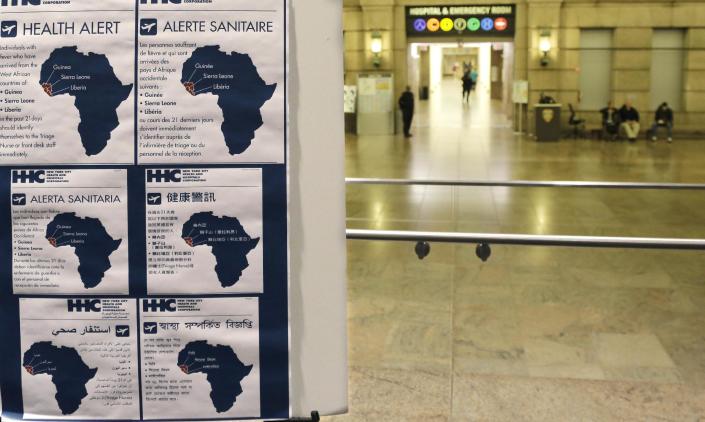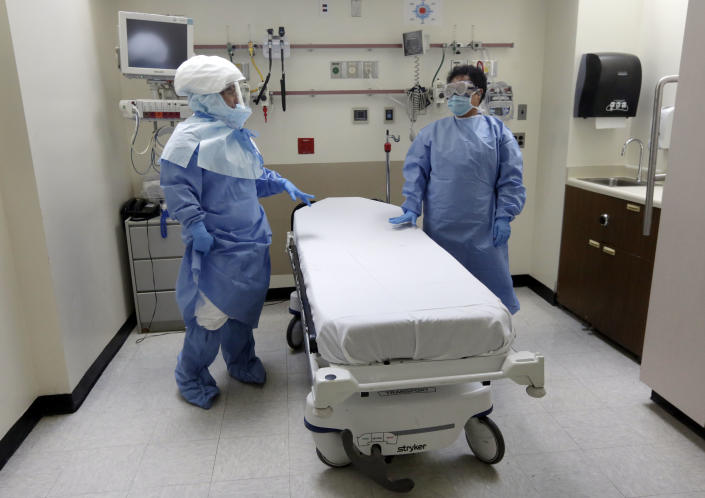Why New York’s Ebola case won’t be a rerun of Dallas's
City officials say they watched Duncan’s case closely — and won’t make the same mistakes

NEW YORK — Craig Spencer, a 33-year-old Doctors Without Borders physician who recently returned from Guinea, became the fourth person ever diagnosed with Ebola on U.S. soil on Thursday night. He was rushed to Bellevue Hospital Center by paramedics in hazmat suits and placed in the site’s isolation ward.
But New York officials quickly insisted that the city’s first Ebola case will be handled completely differently than Liberian Thomas Eric Duncan’s in Texas.
Duncan was turned away from Texas Health Presbyterian Hospital in Dallas when health care workers failed to connect his West African travel history and high fever to the deadly virus that’s killed nearly 5,000 people so far. He returned a few days later in a regular ambulance to be treated by doctors and nurses who did not have their skin fully covered by protective gear. Duncan died and two of the nurses who cared for him also fell ill with Ebola.
Local and national officials were criticized for bungling the response — not getting Duncan’s family members into quarantine quickly, failing to diagnose Ebola and exposing inadequately prepared health care workers to the deadly virus.
While all this played out, New York was watching.

More than a week ago, the city’s health department officially designated Bellevue Hospital Center, the country’s oldest public hospital, the site where any possible Ebola patients would be transferred. In July, the city began stockpiling the hazmat suits nurses and physicians would need if a case materialized. They hired paid actors to walk into hospitals in the city and present Ebola symptoms, to test their emergency rooms’ ability to diagnose the disease and then quickly isolate the patient. Gov. Andrew Cuomo announced that the city’s subway system would also practice how to handle a situation in which an Ebola-infected person became ill on the train in realistic drills.
In press conferences about the city’s first Ebola patient, New York officials admitted that they watched mistakes in Dallas and learned.
"We have had the advantage of learning from the Dallas situation,” Cuomo said on Thursday night.
Mayor Bill De Blasio praised Dallas officials on Friday for being "forthright" about the mistakes they made. "We learned from Dallas," he said.
One of the key differences in New York’s response is that the city designated a single hospital as the go-to place for Ebola patients. While every hospital was expected to be able to diagnose an Ebola patient, special training on how to care for an Ebola patient without infecting yourself was concentrated at Bellevue in Manhattan. (Seven other city hospitals have also volunteered to create Ebola isolation units in case more are needed.)
"We've been training for two and a half months for this," said Ram Raju, the president of the New York City Health and Hospitals Corporation. Nurses have drilled repeatedly in putting on and taking off their personal protective equipment.
Bellevue has an infectious diseases ward with four single-bed rooms in it. The hospital also has a new laboratory where it could safely handle Ebola blood samples.
The ward has taken in patients with tuberculosis and other infectious diseases before, though this is its first patient with Ebola.
“Bellevue is legendary,” New York City Mayor Bill de Blasio said on Thursday night. “They are the most battle-tested.”

The hospital quickly placed Spencer’s fiancee in quarantine, just in case she had been exposed — two other contacts of Spencer’s have been quarantined as well. The city’s health department deployed a team of “disease detectives” to track down any additional contacts who should be quarantined and monitored.
The Centers for Disease Control and Protection sent one of its new rapid-response teams to assist the hospital, President Barack Obama told de Blasio on Thursday night. CDC Director Thomas Frieden said earlier this month after the two Dallas nurses contracted the disease that with the benefit of “20/20 hindsight” he realized his agency should have been more hands-on in helping the hospital with infection control.
Indeed, the most important test for New York’s response is whether the health care workers caring for Spencer contract the disease themselves. More than 440 people caring for Ebola patients in West Africa have contracted the disease this year, and half of them have died. The virus is not airborne and is spread only through direct contact with body fluids, but health care workers are at high risk for falling ill because they come into contact with the fluids.
After Duncan died and two nurses who cared for him got sick, Frieden announced his agency would send a team of infectious disease specialists to any future hospital that received an Ebola patient, to prevent health care workers from falling ill. One of their main functions is to supervise the nurses and physicians as they put on and take off their protective gear, which covers their entire bodies. Experts believe that health care workers often contaminate themselves while taking off their gear — all it takes is a drop of body fluid to transfer from the gloves or gowns into their eyes, nose or mouth.
The city’s health department says it is also working closely with Bellevue to ensure that hospital staff carefully follow all relevant safety guidelines and protocols.
Bellevue’s nurses and doctors also have advantages over Texas Health Presbyterian’s staff now that the CDC has clearer protocols in place. At first the agency recommended that those caring for Ebola patients simply wear a gown, gloves and facemask. It has since made those standards more rigorous, recommending that health care workers cover their skin entirely and wear a special respirator facemask.





